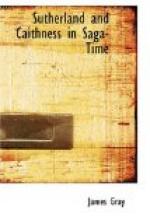Hugo Freskyn’s eldest son, William, Lord of Sutherland, was simply “William de Sutherlandia” on the 31st August 1232, and “W. de Suthyrland” appears as a witness to a grant of a mill on 10th October 1237. But William, Hugo’s son, was by Alexander II created Earl of Sutherland, as we hope to show, soon after 1237, probably as a reward for long and loyal service to William the Lion and to Alexander II, between the year 1200 and the date of his creation, in the various difficulties and rebellions in Moray and Caithness, between which two centres of disaffection his territory of Sutherland lay.[22] For William’s family had then its “three descents” and more, and its chief had a sufficient body of retainers settled on the land to entitle him to the dignity of an earldom. That he was earl there is no doubt, because a deed of 1275 settling litigation between the Earl William of that date and the Bishop of Caithness refers to William of glorious memory and William his son, earls of Sutherland, nobiles viros, Willelmum clare memorie et Willelmum ejus filium, comites Sutthirlandie, (c.f. The Sutherland Book, p. 7).
The first four generations of the Freskyn family seem to be also clearly proved in one line of a grant by William the Lion to Gaufrid Blundus, burgess of Inverness, of 2nd May (year omitted) which is attested “Willelmo filio Freskin Hugone filio suo et Willelmo filio ejus,” which is strange Latin, but embraces all four generations. It is quoted in the New Spalding Club’s Records of Elgin, p. 4, as from Act Parl. Scot, vol. 1, p. 79. The Charter is dated at Elgin probably near the end of the twelfth century, when William Mac-Frisgyn, Hugo, and William of Sutherland were all alive. Not a single member of the family was, as every Fleming was, styled “Flandrensis” in any charter or writ, and Fretheskin is probably a Gaelic name, of which the latter part may mean “knife” or “dagger.” The name does not mean Flemish or Frisian.
Having now introduced the various prominent persons in the north of Scotland over seven hundred years ago, both on the Norse and on the Scottish sides, let us now look more closely and in detail at the main events which had been taking place there and elsewhere since the end of the reign of David I, when his grandson Malcolm IV, known as The Maiden, succeeded in 1153.
The first event in the brilliant reign of this boy king was the invasion and plundering of Aberdeen by Eystein king of Norway about 1153,[23] in repelling which the feudal Barons of Moray and Angus, including the first Freskyn of Duffus and his son William MacFrisgyn, must have been of service. In the same year Somarled of Argyll and the sons of MacHeth engaged in a joint rebellion, which lasted three years until the eldest of them, Donald, was taken and placed as a prisoner with his father in Roxburgh Castle, leaving Somarled to continue the war alone. This war was put an end to by the release of Malcolm MacHeth, who was




